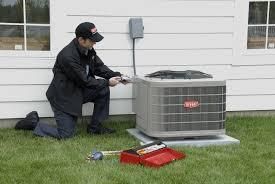These days it seems like you can accomplish almost any task with the touch of a button on your smart phone or tablet device. Well now, with Bryant’s Evolution Connex Control, you can control the temperature in your house too, even if you’re not home.
But really, it’s not just the temperature that you have access too. Also control the humidifier, the ventilator, the fans, and the air purifier as well as air flow to each zone for up to 8 zones. Heading up north for the weekend but forgot to turn the A/C off at your house? No problem: switch it to “vacation” mode on the drive up. And just like typical thermostats, set yours with daytime and nighttime modes.
The Connex control works with your existing wifi connection to have control at your fingertips. The in-home control utilizes a full-color touch-screen display for incredibly easy to manage functions. On the panel you can also access a five-day weather forecast and set up reminders for when you need to change the air filter and when your products should be serviced.
The Connex Control comes with a 10-year parts limited warranty and options for a dedicated wireless router, remote sensor application, and system access module allowing it to be set up with a larger home automation system.
With “Smart Setback,” it actively manages output and ramp up to create the best energy savings while your are away. The system is excellent for energy-saving by regulating the temperature and keeping it consistent. Less fluctuation means less costs.
The Connex control panel accesses your Bryant highest-efficiency Evolution heating, cooling, ventilating, and humidifying solutions. The Evolution System utilizes a longer, lower-stage operation to use the least amount of energy and keep temperatures in the house consistent. It’s been rated by Energy Star as “most efficient” and can save a lot of money on heating and cooling bills. Plus, with the consistent lower-stage operation paired with our mufflers, you will hardly notice noise coming from the units at all. To learn more about Bryant’s Evolution System, check out the video from their site, here: http://www.bryant.com/mediacenter/videos/index.shtml#
At Engelsma, we are proud to feature Bryant products, a company with more than a century of experience in the heating and cooling industry and a company that produces a full range of durable and high quality products that save you money and make your home comfortable. Combined with our 30 years of experience in Grand Rapids and the surrounding area, we are certain that we can provide with you the optimal system for your home at competitive pricing. Customer satisfaction is our number one priority; see how we can help you, today.

 Winter is finally on the wane, and spring is just around the corner. It’s time to dig out your spring chore list, because before you know it, you’ll be turning on your air conditioner to escape the summer heat.
Winter is finally on the wane, and spring is just around the corner. It’s time to dig out your spring chore list, because before you know it, you’ll be turning on your air conditioner to escape the summer heat. 




